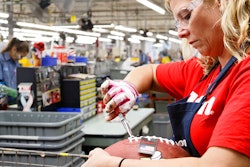Industrial distributors, take note: Customers have formed new allegiances.
The customer loyalty of years past was built on a personal relationship, one that was mutually viewed by distributors and buyers as an ironclad agreement. The comfort of familiarity doesn’t carry the same currency anymore.
Instead, customers are motivated by lower prices, how quickly a particular vendor can answer their question or which company has the most convenient website. This trend is fueled by the growth of e-commerce, which allows buyers of industrial products to shop around with more ease than ever before.
Put another way: Customers are now more loyal to an experience than a company and its people.
According to the UPS Industrial Buying Dynamics study, 38 percent of industrial product buyers went outside their supply base in the prior year to buy online from someone new, and 72 percent said they would shift spending to a distributor with a more user-friendly website.
This isn’t meant to scare mid-size distributors. This study provides them with a roadmap for how best to respond to a rapidly evolving marketplace, identifying new ways to build loyalty that can transcend barriers in these changing times.
The industrial distributor business model has been a tremendous American success story. Bridging the gap between manufacturers and industrial buyers, distributors have provided a valuable layer of convenience and service to their customers.
Industrial distributors will continue to do so, albeit with a different formula, which is driven by some key market forces.
Swelling Buyer Expectations
The UPS study of 1,500 purchasing professionals, conducted with global research firm TNS, shows that distributors must develop a more integrated and user friendly buying process to grow their customer base.
Buyers are reassessing the importance of keeping purchases within an established supply base. With technology making it easy to take out the middle men, so to speak, distributors must clearly assess whether they are delivering on customer expectations.
Buyers care less about traditional business relationships than websites that track their order histories and verify products are in stock. Buyers want immediate, detailed answers to their questions. If they can’t get such information from their usual distributor, they’ll look elsewhere.
Part of the quandary for mid-size distributors is carving out a clearly-defined space in the marketplace. If smaller competitors are known for personal service and larger companies typically offer lower prices, what does this mean for mid-size distributors?
Distributors in that camp now have the opportunity to meet needs too often neglected by larger and smaller businesses. For example, the UPS study found that buyers are least-satisfied with added-value services and physical locations.
At a minimum, distributors can look for low-cost ways to address these concerns. When crafting a plan, remember that word-of-mouth and personal references are used most often to research a new distributor (60 percent), according to the UPS data. Buyers also rely on a distributor’s website more regularly than a sales representative.
Lastly, a company’s website should help deliver an omnichannel experience, allowing a customer to complete various stages of the purchasing process through different mediums — a buyer could start an order online, for example, and pick up the phone to get more specific answers needed to complete a transaction.
Growth Of Direct-From-Manufacturer Purchases
Here’s a statistic not likely to please distributors: 64 percent of respondents to the UPS survey said their companies have already bought directly from manufacturers. Eighty-eight percent of those surveyed also said they are either somewhat likely or very likely to increase direct purchases from manufacturers.
This trend isn’t necessarily catastrophic for distributors.
With a focused strategy, distributors can address sales support, customer service, returns, physical locations, repairs and other areas that aren’t traditionally strong suits for certain manufacturers. And when utilized correctly, manufacturers can provide a new source of revenue for distributors.
Figuring Out The Right Formula For E-commerce
Industrial distributors are hardly alone in trying to navigate a business environment in which a growing part of the sales process is taking place online. Regardless of whether e-commerce completely replaces more traditional channels, distributors must plan for a world where the Internet is the foundation across which nearly all interactions take place. Investments in e-commerce cannot be neglected, no matter how daunting they may appear.
Forrester Research estimates that B2B e-commerce will exceed $1 trillion by the end of 2020, four times as high as the current total.
Most buyers are spending nearly half of their budgets on distributor websites, data shows, and roughly two-thirds say they are either somewhat likely or very likely to shift spending to a more user-friendly website — the onus is on distributors to meet that need.
Plan Ahead For Millenials
Any long-term strategy for success is not complete without a blueprint for addressing the needs of those born in the 1980s and 1990s. Of all demographics, so-called Millenials are the most responsible for driving up expectations for the buying process — they put more value on experience than any of their peers. Not surprisingly, they are the most likely to make purchases online.
Think of this age group as the next generation of purchasing executives.
Though this is a red flag in some circles — Millenials are the likeliest group to change suppliers if their price demands aren’t met — the demographic will essentially evaluate how well a distributor has positioned itself for the future. Brand loyalty may be difficult to achieve with Millenials, but they too can be won over by user-friendly websites that provide a trove of information unavailable anywhere else. This is why Millenials are increasingly turning to third-party websites, which cater to such a clientele.
This group may not yet have the purchasing power to force a complete overhaul of a distributor’s business model, but it represents the terrain on which the gains of the future will be won or lost. Don’t wait until it’s too late to make inroads with a demographic that must be catered to early and often.
The New Business Relationship
These findings are not meant to downplay the importance of relationships, long the bedrock of many distributors’ business models. The people-centric approach must be adjusted, however, to ensure an effective business relationship by today’s standards. Though many buyers still want superior service, they’ll show no hesitation in going somewhere else they deem faster, easier, cheaper or clearer.
Brian Littlefield is the director of marketing for the aerospace, automotive, and industrial manufacturing and distribution segments at UPS.



















